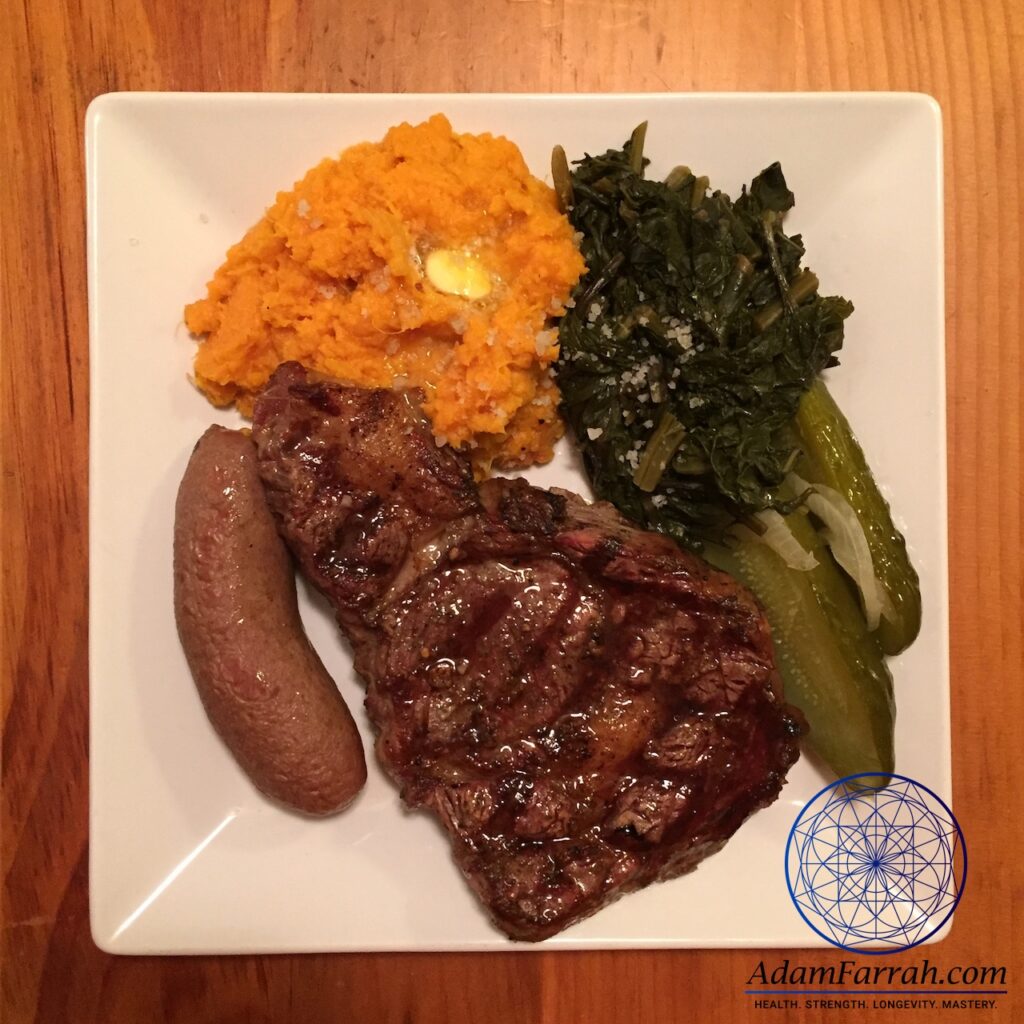
Eating for ulcerative colitis isn’t about complexity. It’s about simple foods and simple meals.
It’s about foods that are whole and close to their natural, unprocessed state.
It’s about calming the immune system down.
It’s about the right fundamentals repeated with consistency and refined over time.
What are the fundamentals?
Eat meat, vegetables and fruit.
No grains.
No dairy.
No eggs.
No processed junk.
No nuts or seeds.
No nightshade vegetables (tomatoes, peppers, eggplant, white potato).
And no cheating with junk foods or any other food that doesn’t fit an autoimmune diet template!
This is the basic Paleo or Primal eating model modified specifically for autoimmune disease and more specifically for ulcerative colitis.
Diet is the Foundation for Everything when Healing Ulcerative Colitis
Back when I was struggling with severe UC from 2004-2009, most doctors and gastroenterologists I saw asserted that diet had nothing to do with ulcerative colitis.
Several doctors I saw in those early days became quite triggered and hostile at the mere mention of diet having anything to do with UC. It wasn’t even possible to have a conversation about it.
I still hear about this happening today, but it’s less and less.
More and more doctors are acknowledging that things like food and stress play a role in UC and in flare-ups.
But still there’s this question of diet.
Which diet?
On first look, there’s a bewildering array of diets, authors, personalities and debates.
Vegetarian, vegan, pescatarian, Paleo, Zone-Paleo, Keto, Keto-Paleo, Specific Carbohydrate Diet, rotation diets, macrobiotic diets. High-carb, low-carb and rotating carbohydrate diets.
How about cyclic ketogenic diets?
And what about fasting? Long-term or short-term?
Intermittent fasting?
What about eating for blood type?
Or food allergy testing?
Are whole grains good?
Isn’t meat bad for you?
Fermented raw cow dairy is good, right?
Or is it goat dairy that’s non-allergenic and safe for UC?
“My diet and method is right.”
“No, mine is!”
“My karate is better than your karate!”
Ugggh…
In this post, I’m going to show you the meals and foods that have kept me free of ulcerative colitis flare-ups for years now.
What About Medication for Ulcerative Colitis?
I’ve talked to people on high dosages of Humira, Remicade, prednisone Lialda, Asacol, Entyvio and even combinations of these drugs who are still flaring.
One poor guy was on 60mg of prednisone and Entyvio and still flaring. Wow.
Without the diet handled, nothing good is going to happen with UC.
(If you want to dig into all the details of eating for UC and the theory behind it all, you can read Healing Ulcerative Colitis with Diet – The Principal Guide.)
Even if you choose to go the medication route, you still need to be looking at your diet. Diet has everything to do with UC.
I recently had a coaching client on Remicade who lessened her medication on her doctor’s recommendation because her inflammation decreased on the Paleo autoimmune diet I put her on.
[Tamara Testimonial Here]
Medication or not, diet is key to dealing with UC long term.
Eating for Ulcerative Colitis – The Big Picture
At first glance, it seems there are thousands of diets.
Every day a new diet and a new theory and a new pundit with another book to sell seems to appear.
Truthfully, there are only a handful of actual diets.
Everything else is just a variation on a theme.
There are vegetarian variations including vegan and raw vegan, there are all the Paleo variations like Paleo, Keto, Primal Blueprint, Carnivore, etc.
Those are like opposite ends of the spectrum. Sort of.
In between are diets that include various grains or that eliminate certain meats and not others. Eating fish, eggs and cheese but not beef or pork, for example. Or avoiding wheat while including supposedly “safe” grains.
Here’s What You Need to Know About Diet for UC
A modified Paleo model is the diet model for UC because it already excludes the major flare-up triggers – grains and dairy.
The meat question comes up a lot and is argued passionately on both sides.
For ulcerative colitis, meat from healthy, properly raised animals is essential for healing.
The animal fat and protein helps the gut wall repair itself. It gives the body the raw materials to heal and rebuild.
A vegetarian diet is not sustainable long-term for human health. Further, a vegan or vegetarian diet is not going to be a good fit for UC long-term. The lack of quality fats and proteins will catch up with you over time.
An autoimmune Paleo diet is the diet for ulcerative colitis.
There is no vegan or vegetarian diet for UC.
(This doesn’t mean there aren’t claimed vegan and vegetarian diets for UC. Plenty of authors and coaches have one to sell you, I’m just saying it won’t work long-term. Try and see if you don’t believe me.)
Real-World Autoimmune Eating for Ulcerative Colitis
Food has a profound effect on the immune system.
The major UC triggers are grains and dairy.
Eggs are another big one.
Meat is quite neutral relative to the immune system – provided it’s from healthy animals eating grass and/or proper diet, with good husbandry, etc.
Most vegetables and fruits are easy on the immune system also. (Though with UC, the fiber can be a problem – especially in the early days or during a flare-up. I’ll address this shortly.)
So, we’re back to this meat, vegetables and fruit model. The basic Paleo model that our genes have been exposed to for several million years.
The Paleo Model
The Paleo Diet was originally a book written by author and researcher Loren Cordain, a Professor Emeritus in the Department of Health and Exercise Science at Colorado State University.
The book was published in 2001. That’s over 20 years ago.
And there were versions of this “eat like your ancestors model” way before Dr. Cordain and Robb Wolf took it mainstream around 2010.
The basic idea is that the Paleolithic foods – those that could be hunted or gathered – have been around for a much longer period of time than agricultural foods.
Agricultural foods being mainly grains and dairy.
Our genes are essentially the same as they were in the Paleolithic era.
But modern food is very, very different from the food our Paleo ancestors ate and that our Paleolithic genes have adapted to.
Ulcerative Colitis and Neolithic Foods
Though things like bread, milk and cheese seem like “staples” to us that have been around “forever,” on the evolutionary timeline these foods are very new.
Humans have only consumed grains and dairy as staples for about 10,000 years.
Our ancestors were able to survive and thrive for over 2 million years on meat, vegetables and fruit, when it was in season.
As soon as agricultural products like wheat and dairy entered our lives on a large scale, health and digestive problems began to emerge.
The following excerpts are from the Wikipedia entries on celiac disease, ulcerative colitis and Crohn’s disease, respectively. Celiac is the oldest.
Ulcerative colitis and Crohn’s weren’t seen until the Industrial Revolution was well underway – note the dates in the Wikipedia entries below.
Ulcerative colitis and Crohn’s disease are diseases of modern food and lifestyles.
Wikipedia Entries on First Recorded Cases of Celiac Disease, Crohn’s Disease and Ulcerative Colitis
Humans first started to cultivate grains in the Neolithic period (beginning about 9500 BCE) in the Fertile Crescent in Western Asia, and it is likely that coeliac disease did not occur before this time. (From: https://en.wikipedia.org/wiki/Coeliac_disease)
The first description of ulcerative colitis occurred around the 1850s. (From: https://en.wikipedia.org/wiki/Ulcerative_colitis)
Inflammatory bowel diseases were described by Giovanni Battista Morgagni (1682–1771) and by Scottish physician T Kennedy Dalzie in 1913. (From: https://en.wikipedia.org/wiki/Crohn’s_disease)
Ileitis terminalis was first described by Polish surgeon Antoni Leśniowski in 1904, although it was not conclusively distinguished from intestinal tuberculosis. In Poland, it is still called Leśniowski-Crohn’s disease (Polish: choroba Leśniowskiego-Crohna). Burrill Bernard Crohn, an American gastroenterologist at New York City’s Mount Sinai Hospital, described fourteen cases in 1932, and submitted them to the American Medical Association under the rubric of “Terminal ileitis: A new clinical entity.” Later that year, he, along with colleagues Leon Ginzburg and Gordon Oppenheimer, published the case series as “Regional ileitis: a pathologic and clinical entity”. However, due to the precedence of Crohn’s name in the alphabet, it later became known in the worldwide literature as Crohn’s disease. (From: https://en.wikipedia.org/wiki/Crohn’s_disease)
Ulcerative colitis is a very new disease, relatively speaking.
From above, ulcerative colitis was first described in the 1850s.
That’s quite new. It’s the modern food and the modern lifestyles.
Ulcerative Colitis is an Autoimmune Disease
Ulcerative colitis is an autoimmune disease.
Years ago, the standard schtick from G.I. doctors was “Ulcerative colitis is an autoimmune disease, diet has nothing to do with it.”
Food has a profound effect on the human immune system and the food we eat consistently really affects the immune system over time.
Some, like Mark Sisson, even argue that our genes are being turned on and off based on what we’re eating on a regular basis and how and where we’re living.
Ulcerative Colitis is Also a Digestive Illness
But, ulcerative colitis is also a digestive illness.
Which came first?
Which came first doesn’t really matter that much.
The point is, with UC you have a systemic autoimmune problem and weak digestion from an inflamed digestive tract.
Some additional attention on how easy the food is to break down, digest and assimilate is required as well.
Especially during flare-ups.
An Autoimmune Paleo Diet Model for Ulcerative Colitis
The basic Paleo diet was a huge step forward. The model is sound, but further modifications are needed for UC and other autoimmune diseases.
Authors like Eileen Laird and Sarah Ballentine took a Paleo Autoimmune Protocol diet “mainstream” within at least the Paleo and a few other diet and health niches.
The Phoenix Helix Podcast
If you have autoimmune issues and are into podcasts, definitely check out Eileen Laird’s Phoenix Helix podcast. I was a guest discussing medical marijuana as well as my own UC journey way back on Episode #33.
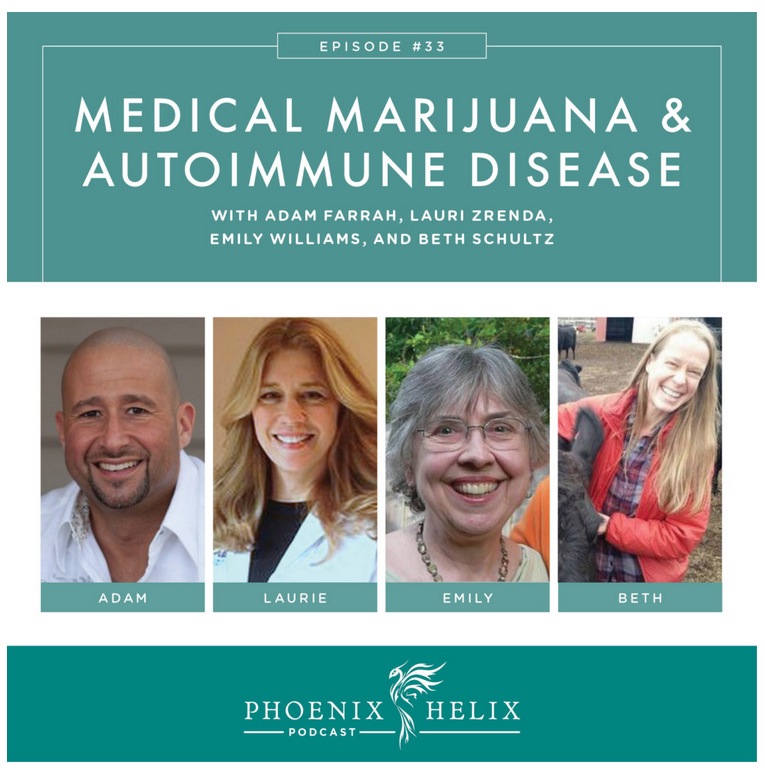
Does the Name of the Diet Matter?
You’ll see the basic dietary template I discuss here called different things. The three primary names you’re likely to see are:
- The Paleo Autoimmune Protocol (Paleo-AIP)
- The Autoimmune Protocol Diet
- The Autoimmune Paleo Diet (AIP)
You’ll also see variations like the Wahls Protocol Diet which is basically the same thing. [LINK https://en.wikipedia.org/wiki/Terry_Wahls#The_Wahls_Protocol_Diet]
You’ll see other autoimmune diets that look like this Paleo-AIP model.
They all come from the same place. The same basic template.
Clinical Studies Showing the Efficacy of the Paleo Autoimmune Eating Model
From the IBD Journal article Efficacy of the Autoimmune Protocol Diet for Inflammatory Bowel Disease:
“The AIP dietary intervention consisted of a 6-week elimination phase (staged elimination of grains, legumes, night- shades, dairy, eggs, coffee, alcohol, nuts and seeds, refined/ processed sugars, oils, and food additives) followed by a 5-week maintenance phase (during which no food group reintroduction was allowed) …”
If you want to look at some of the actual science on how effective this minimalist style of eating can be for IBD, here are two journal articles to get you started:

Efficacy of the Autoimmune Protocol Diet for Inflammatory Bowel Disease
[Adam’s Comment: Interesting that a total of four participants discontinued medication during the trial. At least one of them achieved remission after discontinuing the medication.]

An Autoimmune Protocol Diet Improves Patient-Reported Quality of Life in Inflammatory Bowel Disease
Yes. There’s actual science behind what I’m telling you.
[Adam’s Comment: The above studies are peer-reviewed scientific journal articles. As a whole, the medical establishment is coming around. But your doctor may not be spending time searching for these types of studies. Print them out and bring them on your next visit.]
The Paleo Autoimmune Protocol Template for Healing Ulcerative Colitis
I’m going to give you a fast primer on this autoimmune protocol eating style. Again, there will be different diets that are variations on this theme. The main thing is understanding the way it works and what to eat, what not to eat and why.
Eat Meat and Fish
Meat and fish are staples. Look for grass-fed beef, pastured pork and free-range chickens. Fish should be wild-caught or at least farmed in a clean and organic facility.
Eat Well-Cooked Vegetables
Most vegetables are OK, though there’s some individuality in tolerance on a few of them.
Focus on well-cooked steamed or boiled carrots and boiled kale. These are the easiest to digest in the beginning.
Eat Fresh Fruit – Primarily in Smoothies
Bananas, mango and papaya are the easiest and most reliable fruits with UC.
Smoothies are a staple in my diet even today. I can’t say enough for the mechanical “digestion” offered by a blender.
With UC, we always tend to have weak and compromised digestion. Even after years of healing.
Smoothies are very easy and comfortable to digest, as long as they’re made right.
Avoid These Foods when Autoimmune Protocol Eating for UC
OK, everything from this point on is a big AVOID if you have ulcerative colitis.
Avoid Eggs
These are massively inflammatory and will trigger a flare-up pretty fast. Even free-range eggs from wherever won’t help. Sad to say, eggs are a no.
It’s unfortunate that many diets for UC include eggs. Eggs in the diet are a guaranteed flare-up sooner or later. Probably sooner, actually.
Avoid All Dairy – Even Raw and/or Fermented
Dairy is another guaranteed flare-up. It doesn’t matter if it’s raw. It doesn’t matter if it’s fermented. It doesn’t matter if it’s cow, goat, camel, kangaroo or iguana milk.
I tried to get fermented dairy to work for more than a decade. Even in some Paleo circles it’s considered healthy because of the protein and the probiotics.
Dairy doesn’t work for UC.
None of it does.
Drop all dairy from your diet and you should see a rapid improvement in UC symptoms.
Eliminate All Grains
Grains are another broad category that doesn’t work.
It’s not just gluten, it’s grains. All grains.
Gluten-free grains can still trigger the immune system in people with UC.
Avoid all grains with ulcerative colitis.
Everything.
Amaranth, spelt, buckwheat, quinoa, white and brown rice, gluten-free oatmeal and all the rest need to go.
Yes. Even the basmati rice.
Nuts and Seeds
This is a category of foods that are allowed on regular Paleo, but will be excluded on an autoimmune Paleo diet variation.
For anyone with UC, I suggest eliminating all nuts and seeds.
Incidentally, this is from an autoimmune standpoint, not from nuts or seeds getting stuck in pockets the colon. I think that’s more myth than anything. But that’s just my intuition speaking.
Nightshade Vegetables
These are tomatoes, eggplants, peppers and white potatoes.
I know, white potatoes are excluded on regular Paleo already.
These shouldn’t be hard to live without.
Processed and Junk Foods
This should go without saying. Even a little crap will set you back. Just don’t do it.
My Real-World Meal Examples
As promised, here are my actual meals for you to model and learn from.
The following pictures are right from my kitchen table before dinner. These are the meals and foods I’m actually eating and have been for many years.
I only use Celtic sea salt and fresh-ground organic black pepper for seasoning.
Truthfully, when you use high-quality meat and other ingredients in your food, the flavor takes care of itself.
Your palate also becomes more sensitive and refined. You learn to appreciate the subtle flavors in quality food.
Pulled Pork and Pastured Bacon
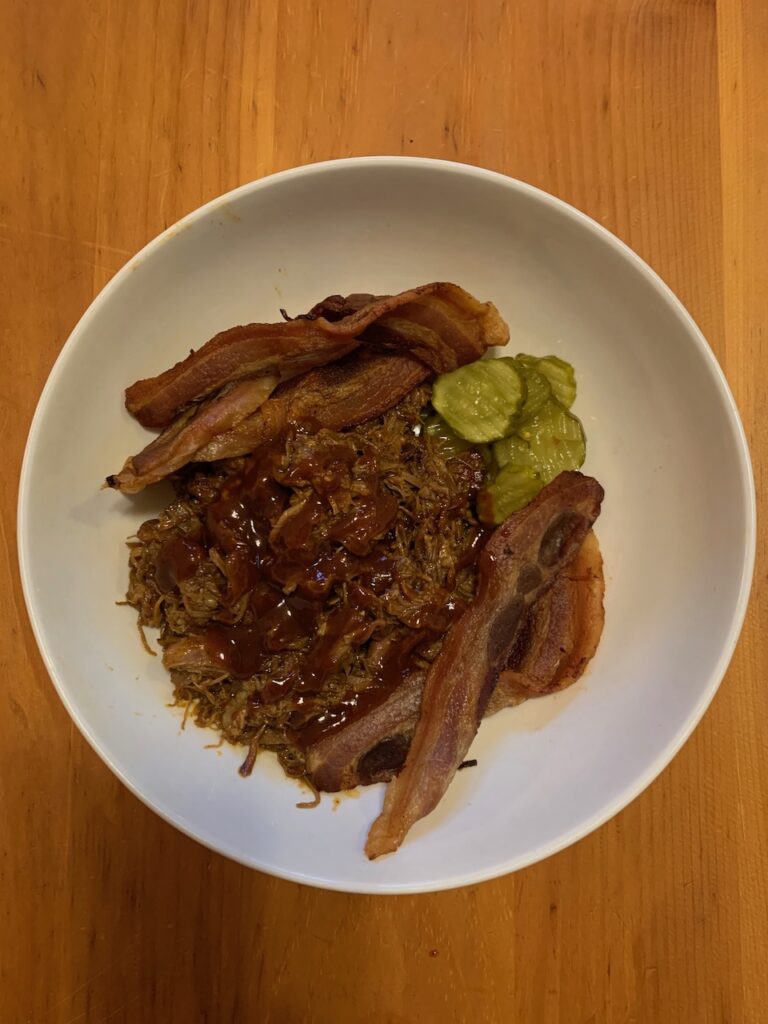
This is slow-cooked pulled pork. The pork is raised on a farm a few miles from my house, Four Mile River Farm in East Lyme. It’s a good one because I can make it in big batches – 5-6 pounds at a time – and easily reheat it for individual meals.
I just season it with salt and pepper and a gluten-free BBQ sauce.
This is an easy one to cook and a big pot of it lasts for a lot of quick and easy meals over the week.
The Big Salad
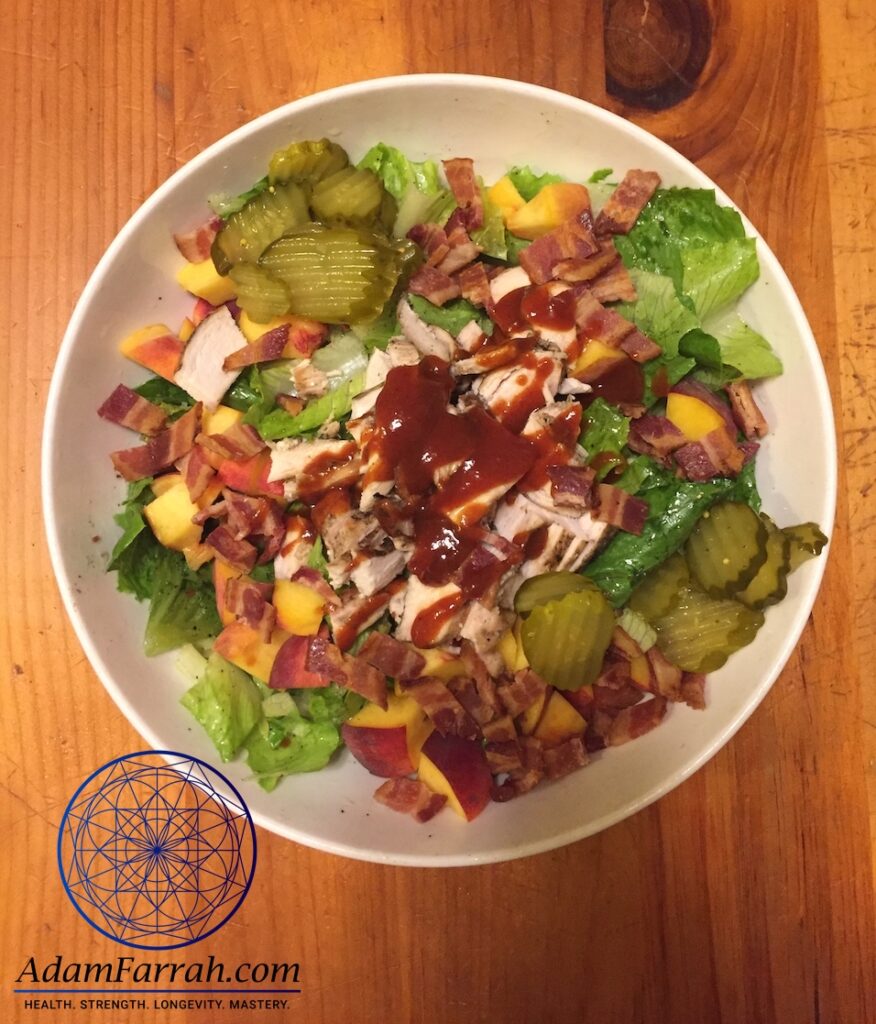
This one is actually not for everyone. If you’re still pretty unhealed and inflamed, the raw lettuce and raw fruit will probably be too much for you.
Anyone who has had UC or Crohn’s for any length of time will know exactly what it means that I can eat a huge bowl of raw lettuce and digest it.
Again, this is advanced stuff and I’m very well-healed. Don’t try this at home, kids.
Remember The Big Salad episode from Seinfeld? This is my Big Salad – Lettuce, roasted chicken, bacon, fresh peaches and pickles. The dressing is just olive oil and vinegar with Celtic sea salt and fresh-ground organic pepper. There’s gluten-free BBQ sauce on the chicken.
Real Food Doesn’t Have a Lot of Packaging and Branding
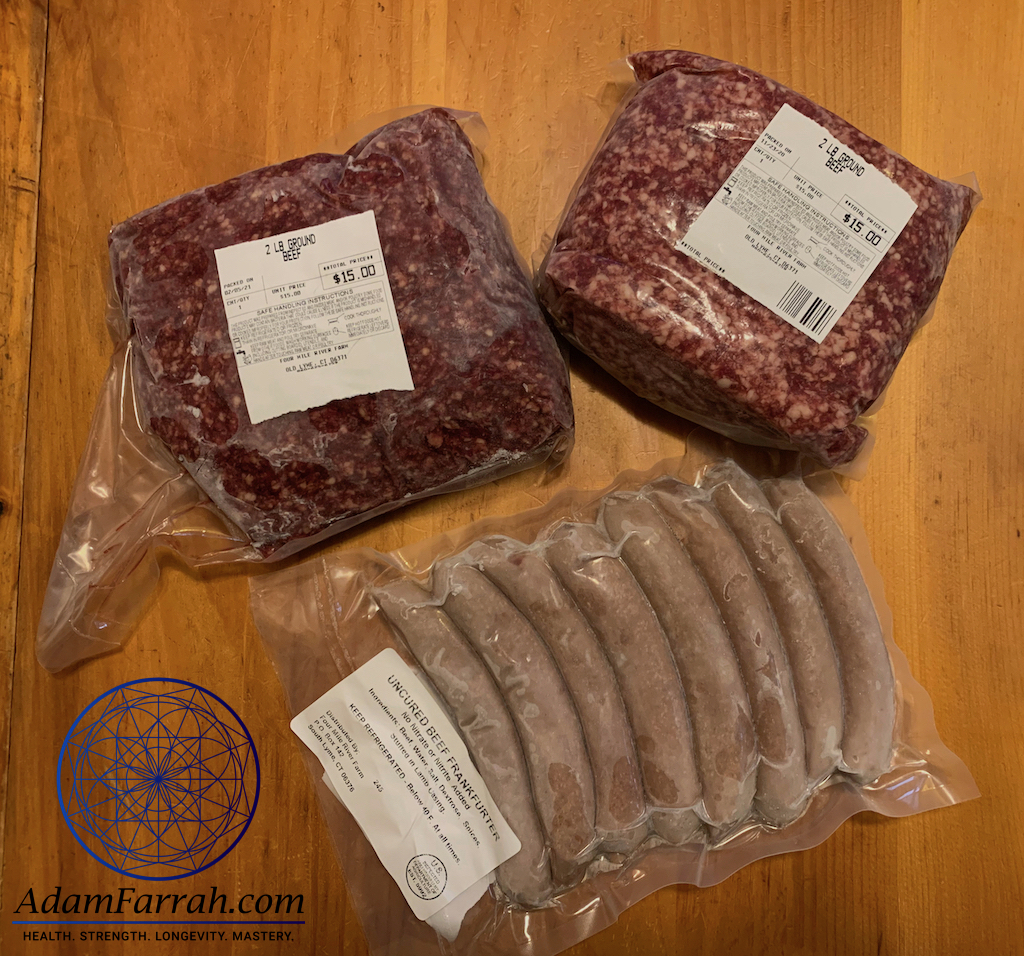
Local, farm-raised ground beef and beef hot dogs. Two of my diet staples.
This is what my meat looks like when I get it. Just plain packaging. Local, fresh and healthy.
It’s better for the planet too.
I stay out of the industrial food chain and off-grid with my food as much as possible.

Local Grass-Fed Beef Jerky
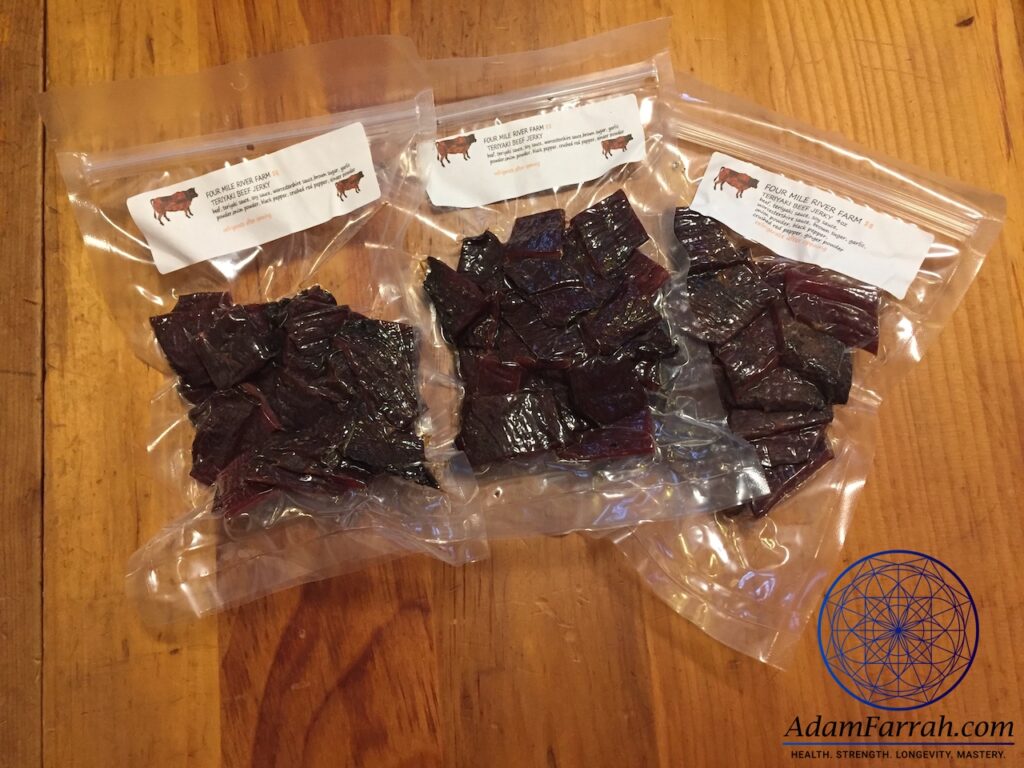
Local grass-fed beef jerky is a great snack, on-the-go meal or travel meal.
My local farm makes this stuff and it’s awesome.
If you want some Paleo-AIP “packaged” food for ulcerative colitis, here you go!
Make sure you watch out for gluten and soy in supermarket jerky products. Look for grass-fed and organic beef jerky if you decide to try some.
Grass-Fed Beef Stew Topped with Bacon

Grass-fed beef stew. An easy, one-pot recipe that can last a whole week. It freezes well, too.
This is an easy, one-pot meal that you can make in big batches and reheat. It’s just carrots, onions and celery, some garlic and Celtic sea salt and fresh ground organic black pepper. I topped this bowl with bacon. The meat is grass-fed stew beef from the local farm, discussed above.
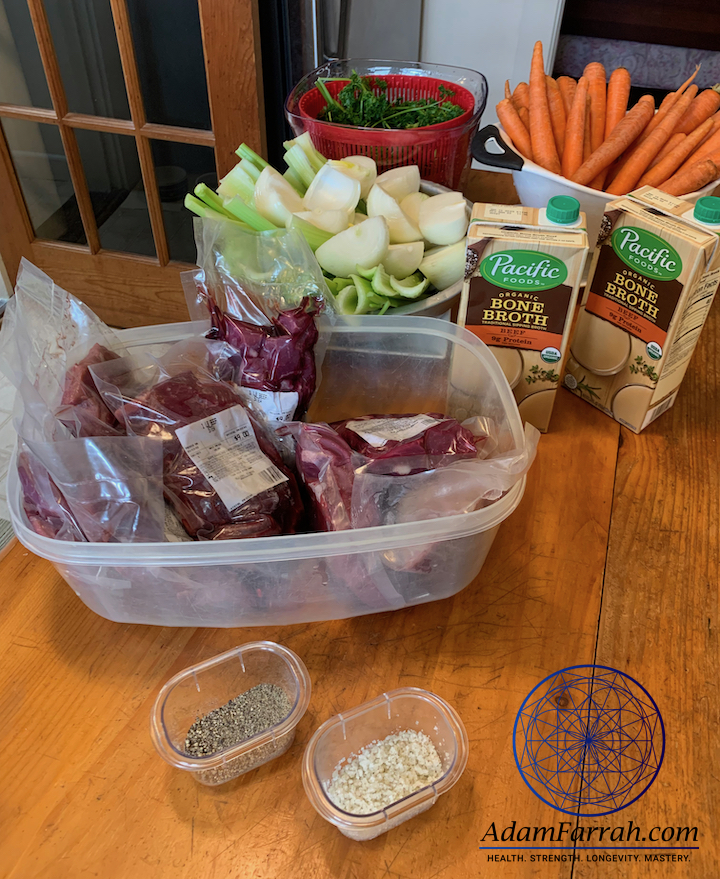
Grass-Fed Burger, Bacon and Sweet Potato
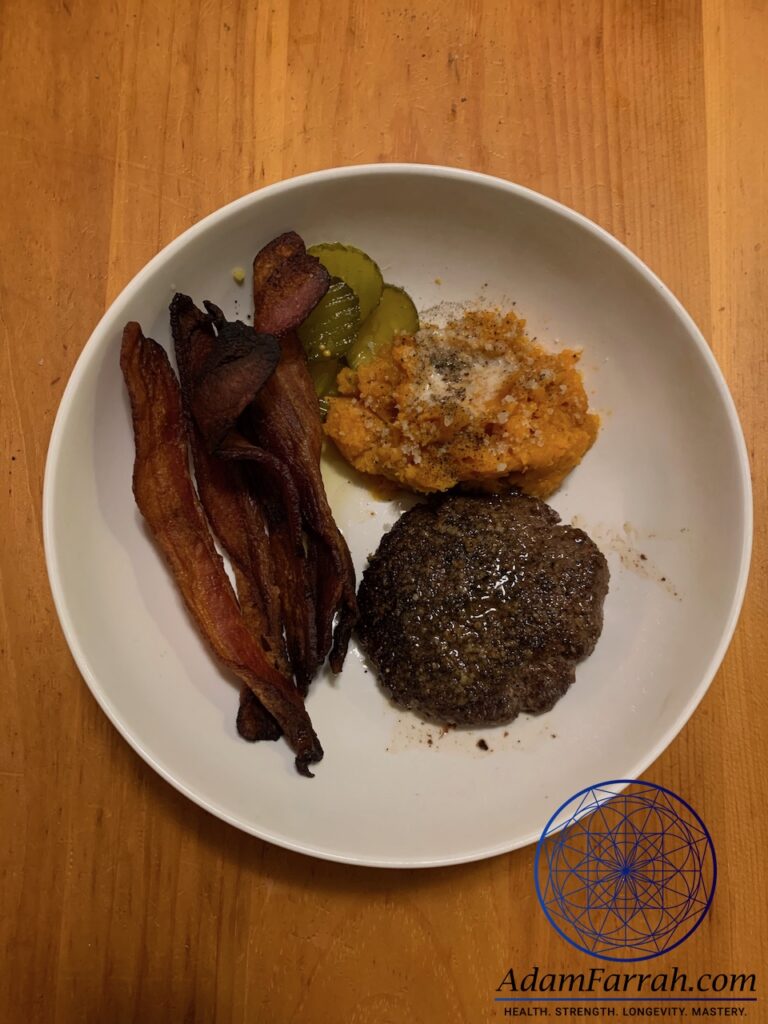
This is a pretty basic meal for ulcerative colitis or Crohn’s. I eat something like this very often.
The butter is an advanced practice and not something everyone should be doing.
There are trace milk solids and dairy proteins in butter that can cause problems.
I’d suggest staying away from butter until you’re really far along in your healing. Even now, I don’t use a lot at all.
[Adam’s Note: For many with UC or Crohn’s, Ghee or coconut butter can be a better option if you’re craving dairy butter.]
Grass-Fed Rib-Eye Steak, Real Pickles, Braised Kale and Sweet Potato

I don’t eat a prime cut of steak like this every night. You can see that most of my meals are average cuts of meat and made in big batches.
Beside the grass-fed rib-eye steak, there are mashed sweet potatoes and butter, braised organic kale, Real Pickles brand spicy pickles and a grass-fed sausage.
Grilled Grass-Fed Beef Hot Dogs, Real Sauerkraut, Real Pickles and Bacon

Not much new here in this one. But I’ll take the opportunity to talk about the pickles and sauerkraut.
Things like pickles, sauerkraut and kimchi are traditionally, fermented foods.
They’re a great, non-dairy source of probiotics. My favorite brand of traditionally fermented pickles, sauerkraut and kimchi is the Real Pickles company in Greenfield, Massachusetts.
Pastured Pork Chops, Grass-Fed Hot Dogs, Braised Kale and Real Pickles
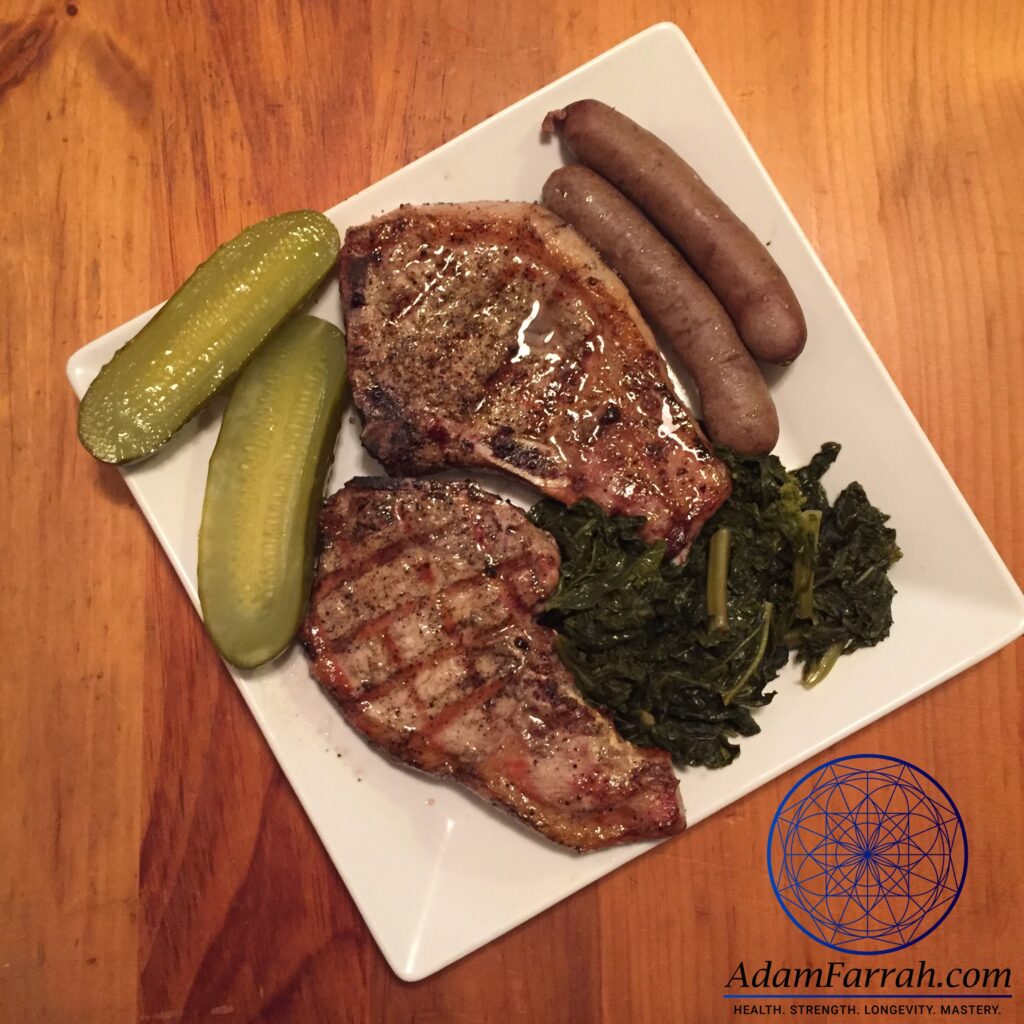
These are local, pastured pork chops and some grass-fed hot dogs. Vegetable is braised kale and pickles are Real Pickles.
Grilled Flank Steak, Braised Summer Vegetables and Real Pickles
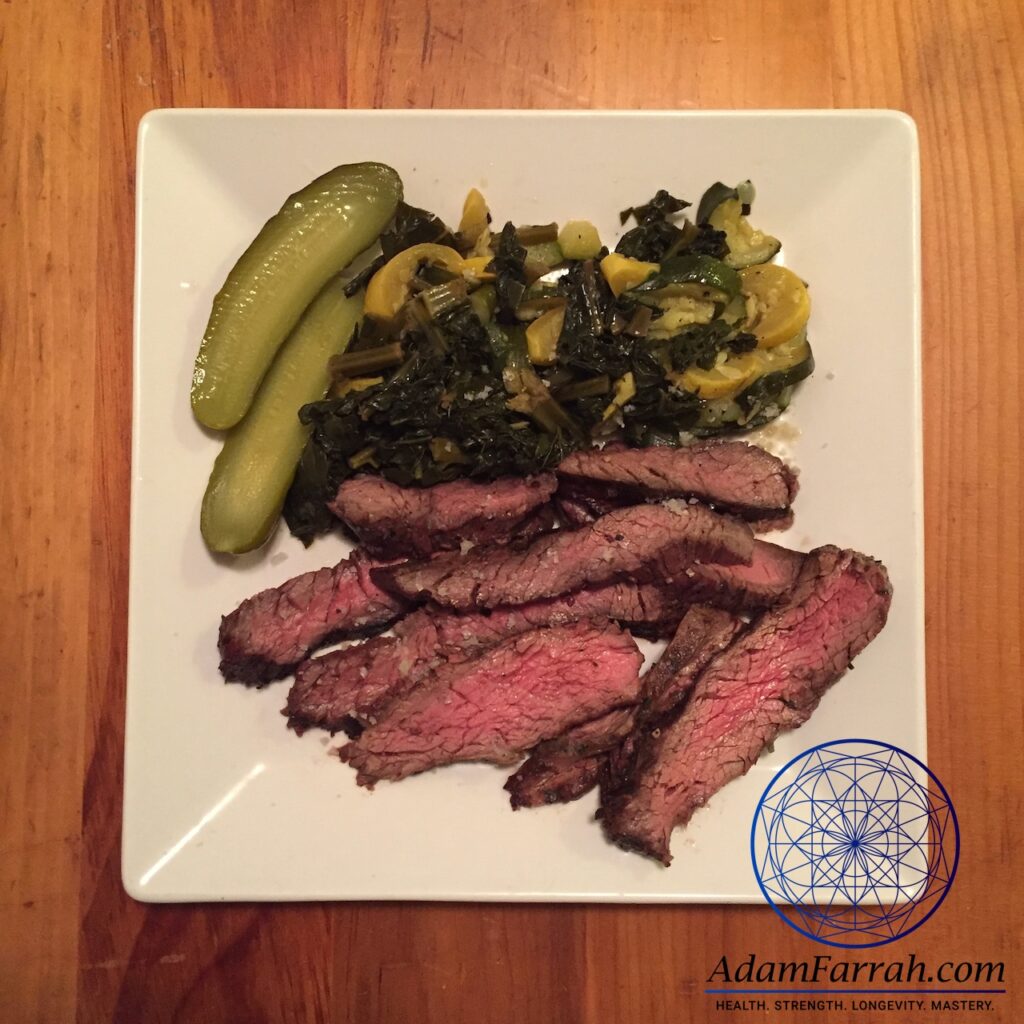
This is a grass-fed flank steak, marinated in fresh lime juice, olive oil, organic garlic and fresh-ground black pepper. Sauteed summer squash and kale are on the side along with the ubiquitous Real Pickles.
Fruit and Hemp Protein Smoothie
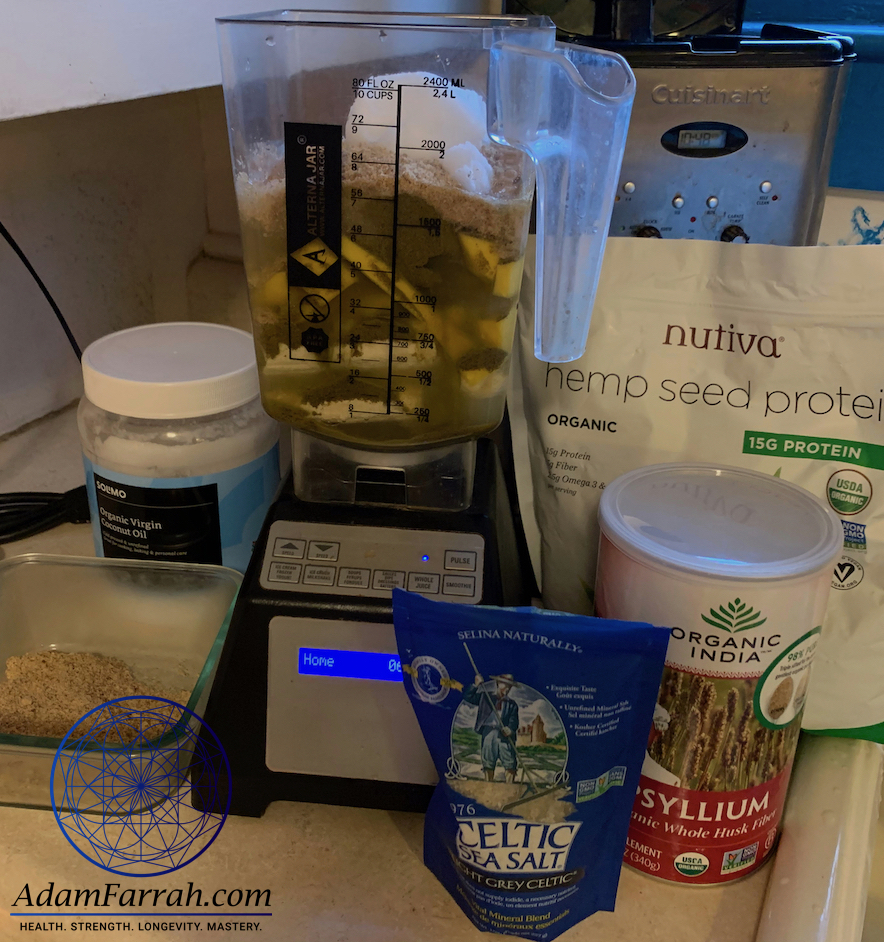
This particular smoothie recipe has been a daily staple for me for many years now:
- Nutiva Hemp Protein Powder
- Fresh bananas
- Fresh fruit like mangoes, strawberries or blueberries
- Organic coconut oil
- Organic India Psyllium Husk Fiber
- Ground Flax Seeds
- Celtic Sea Salt
- Water
This combination of “stuff” blended together is about as close as I’ve found to foods that are actively healing for the gut and UC.
This shake daily makes a HUGE difference in my bowel health and stools.
I’ve been told the same thing by others – with and without UC – who have used the recipe with consistency as well.
A Caveat on the Psyllium Husk Fiber
If you’re not well-healed or are in a flare-up, the psyllium husk fiber will likely be too much for you. Don’t use that ingredient until you’re more healed and your digestive tract is more robust.
A Caveat on the Ground Flax Seeds
This one is kind of a “rule bend.” Flax seeds are not allowed on a strictly Paleo-AIP eating template.
I’ve personally been using them forever and my immune system is fine with them. I feel the additional fiber is quite beneficial for me.
But I’ve tested this in my own body extensively. This is an empirical thing.
Not everyone can handle them.
Here’s the finished shake. It’s really quite good.
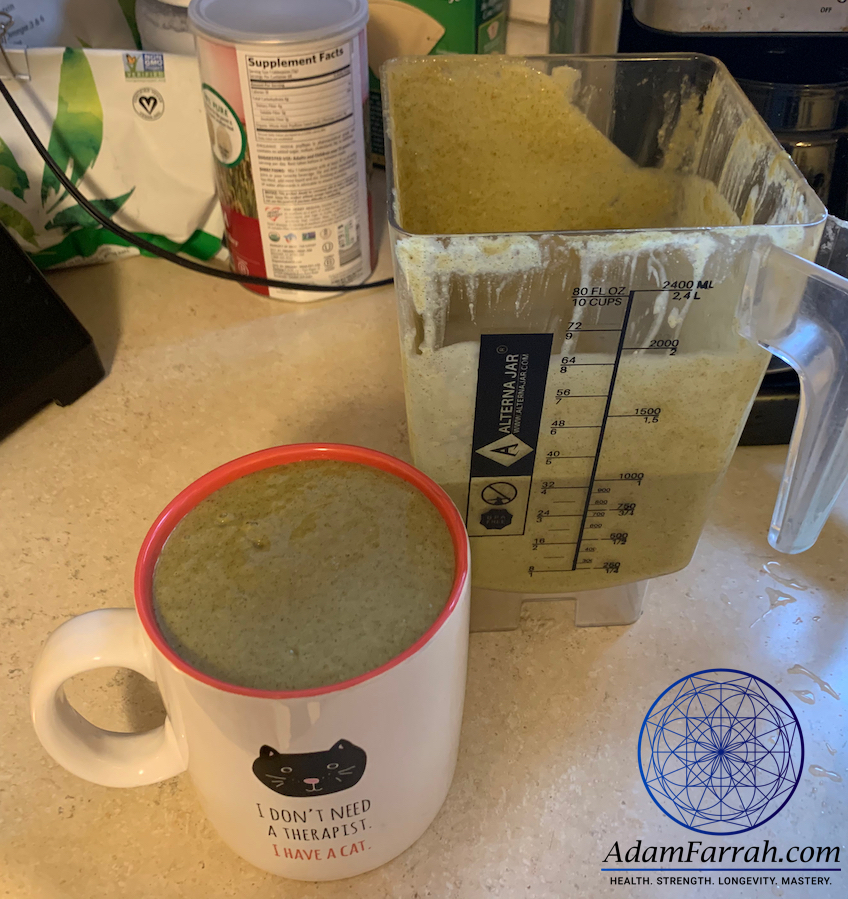
Kombucha Drinks
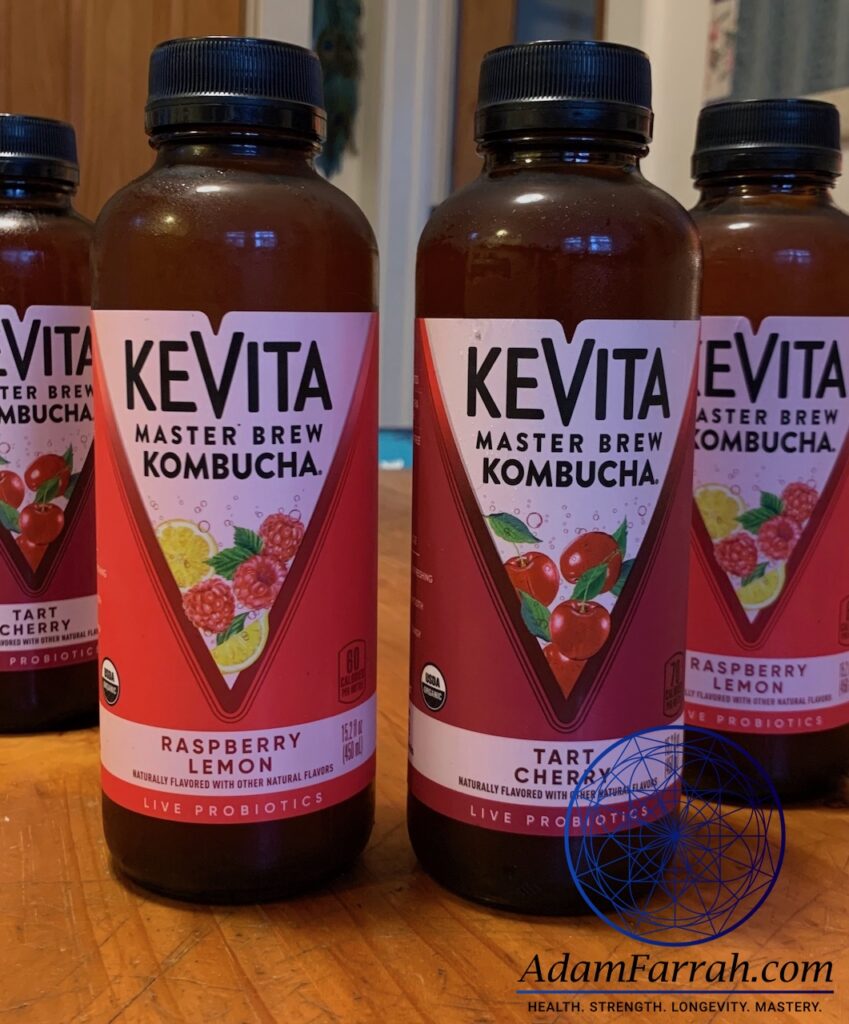
Kombucha has been getting quite popular in the last few years. Most grocery stores carry a bunch of different brands and flavors.
These are kind of like a cross between soda and a wine cooler.
(They don’t really have any alcohol to speak of, but the fermentation process creates a very small amount in the product.)
Not only are kombucha drinks a nice change from water and an enjoyable drink. These are one of the few probiotic sources I use regularly.
Some of these drinks also have caffeine in them. The Kevita varieties above do. If you’re sensitive to caffeine, be careful.
Not Completely Awful Treats
The following meals are really just treats for those times you’re really craving something sugary and sweet and full of carbs.
These really aren’t great for us, but they’re a much better bad choice than some others we can make.
This is the type of stuff I “cheat” with and it’s plenty for me. I don’t need to eat anything worse.
Dried Pineapple and Coconut Dates
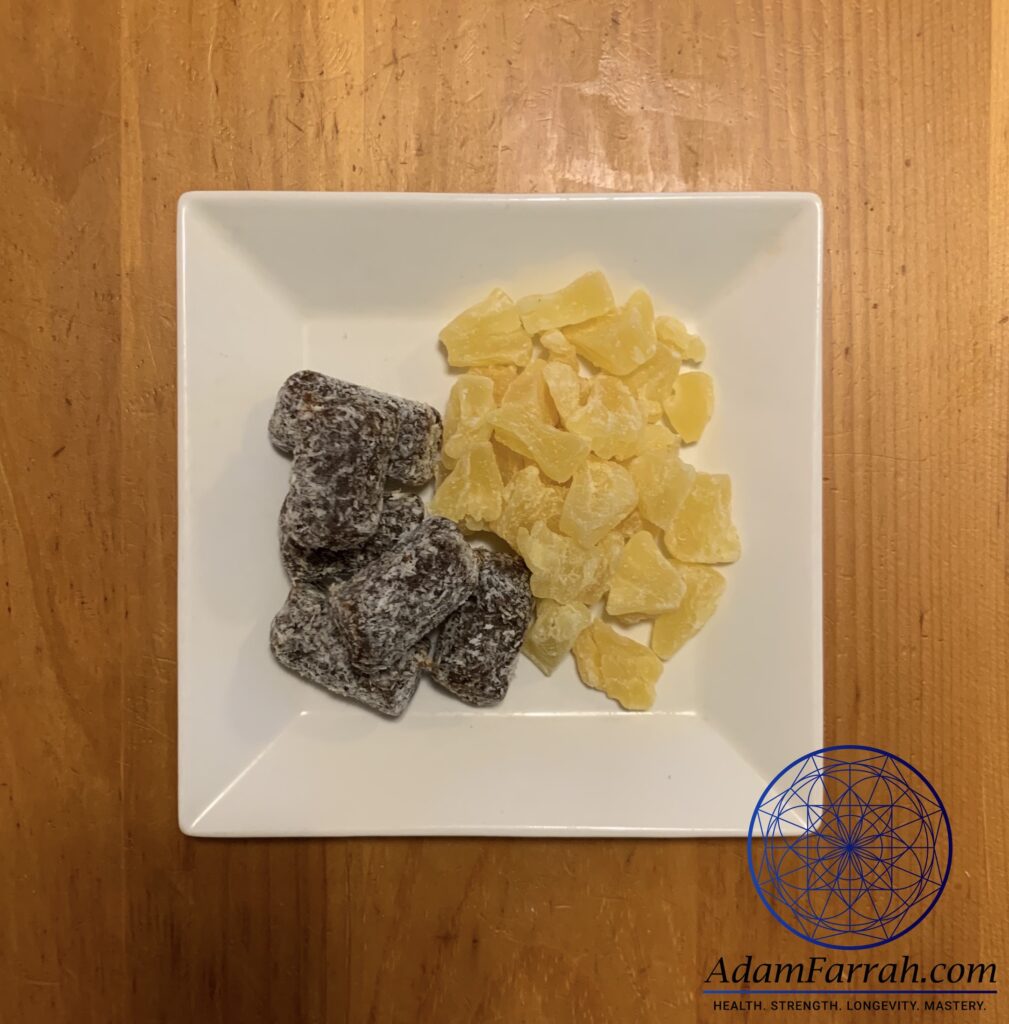
Dried fruits and coconut dates are available at most grocery and health food stores.
High in sugar and not for those who aren’t well-healed, dried fruits can be a welcome sweet treat in an otherwise strict Paleo-AIP food plan.
Treat them like candy and eat them sparingly when you need a treat.
Dried fruits are loaded with carbs and sugar. They can trigger diarrhea or a flare-up. Too much of these, especially the pineapple, can really get you into gastrointestinal discomfort.
Some dried fruits may not work for you at all. Test them individually and be careful.
Dried Fruit
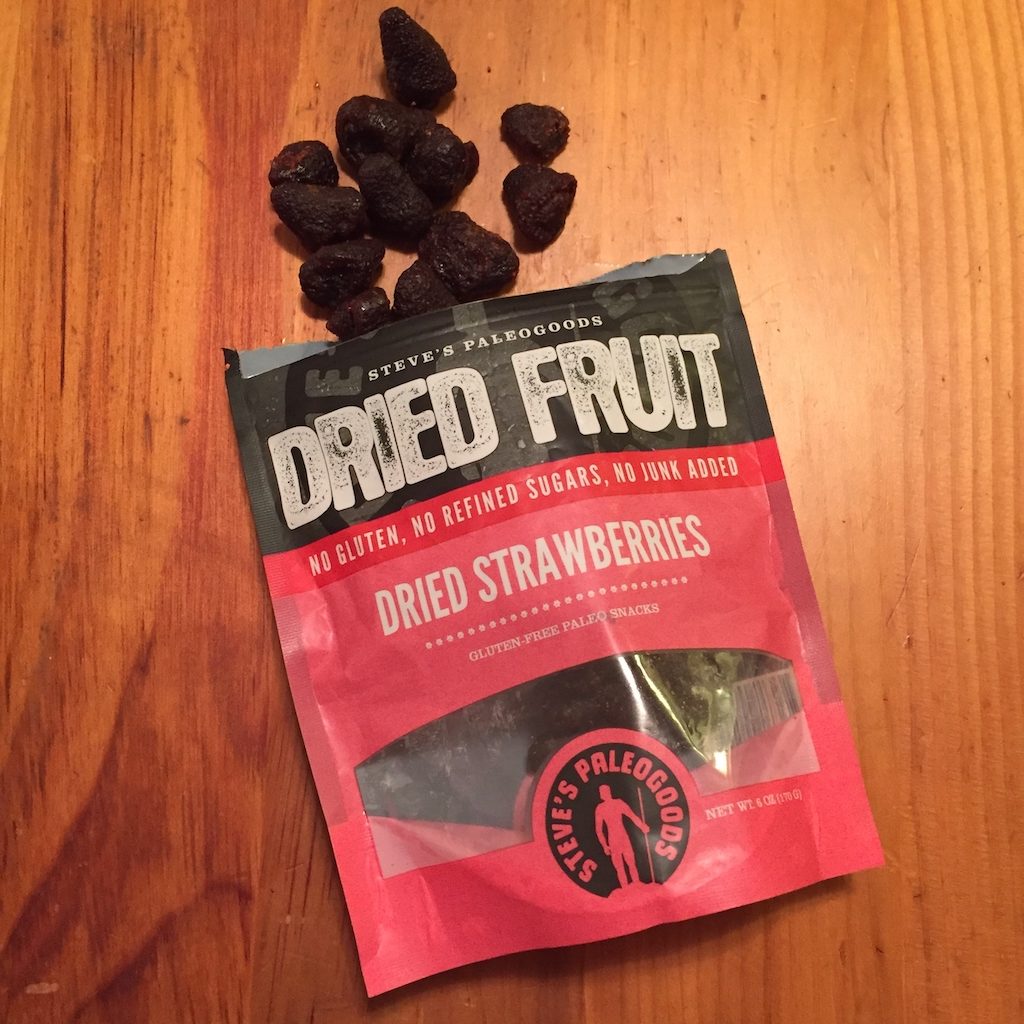
Steve’s Paleogoods in Camden, New Jersey has been around forever. From the beginning of the Paleo thing. Their stuff is awesome.
These are the dried strawberries – my absolute favorites. They’re like strawberry gummy candies!
Mashed Bananas, Hemp Seeds, Dates and Marijuana-Infused Coconut Butter

Mashed bananas, hemp seeds, marijuana-infused coconut butter, dates and almond butter.
This is definitely a Paleo meal and not a Paleo-AIP meal. I do not recommend it to everyone with UC and certainly not in the early stages of getting the illness under control.
Conclusion
I hope you come away from this post with both an appreciation for how well you can actually eat with UC or Crohn’s, as well as a sense of how easy it can be to eat well and stay healthy and flare-up free.
These meals work, they’re simple and you can do them to.
You don’t need anything special to eat like this.
Over time, you’ll develop your own recipes, favorite foods and preferences.
You’ll also figure out which foods work for you and which don’t. Even within this AIP template I’ve given you.
All that’s needed is some planning, preparation and a dose of willpower to get it all started.
For this post, I dug as deep as I could into my daily, long-term food and diet practice.
I’ve included both staples and foods I eat once in a while.
There are expensive foods and less-expensive foods.
There are foods that are quite safe relative to UC and some others that should be eaten sparingly – or not at all by some.
There are foods infused with marijuana like the marijuana infused-coconut butter.
I hope this post helps to demystify food and diet for ulcerative colitis for you.
It’s not about complex diets and theories or magic supplements.
It’s about eating real food, food that doesn’t overstimulate the immune system.
And then doing that with total consistency for a very long time.
Did you learn something new in this post that you can apply to your own healing? Did you try one of these meals yet? Are you going to? Let us know in the comments!
Hi Adam, there seems a lot of meat in this diet.I have problems with low hydrochloric acid in my stomach.Meat is problematic. If legumes are not great for UC, am I going to have to just consume well cooked vegetables? What about tofu?
Hey Rosemary,
A lot of diet for UC is in what you don’t eat.
You’ve got well-cooked vegetables and the fruit smoothies I suggested about halfway through this post.
The hemp protein powder in the smoothies I suggest is pretty safe. Just test it and start slow.
Soybeans are legumes, so no tofu.
What about fish and chicken?
Well-cooked soups and stews?
Sweet potatoes and root vegetables as well as avocados are pretty dense and satisfying. They won’t trigger your immune system.
You can also get a hydrochloric acid supplement called Betaine HCl to help digestion. I never had much luck with it, but you could experiment and see what it does for you.
Some animal protein and animal fat is pretty important for healing when you’ve been as sick as we have with UC.
Well-cooked vegetables and fruit smoothies with hemp protein will be pretty nutritious.
If you can round that out with fish or chicken a few times a week, you should be in good shape.
And add a cod liver oil supplement as well.
By the way, I’m only eating meat once a day. I have a smoothie as my first meal of the day and dinner is a meat and vegetable meal. That’s about it. I’m not eating 3 or 4 of those meals above every day.
Adam
Just discovering I have UC after years of suffering but doctors said test were fine, then switched to a naturopath, huge help.
Are yogurt based smoothies with banana and berries ok ? I’ve almost been living on homemade soups for over a month.
Hello,
What about lentils and other legumes?
Thanks.
UC since 2006
Hey Steve,
Beans, lentils and other legumes are excluded on Paleo and Paleo-AIP. That’s a good catch on your part. I never listed them. I haven’t eaten them in well over a decade. I forgot to even mention them. Thanks!
Incidentally, peanuts are legumes and also excluded on Paleo and Paleo-AIP.
Feel free to jump onto my email newsletter and download the free guide Healing Ulcerative Colitis Naturally if you haven’t already! https://adamfarrah.com/illustrated-roadmap-healing-ulcerative-colitis-naturally/
I’m going to try this diet! This is the most sensible diet Ive read in a long time! All the GI Drs I’ve had always say there’s no special diet for UC. I’m going on my 4th biologic! So hopefully I’ll be able to eliminate the meds by controlling my diet! Wish me luck! Thank you so much for your help!
Hey Linda!
Glad this was helpful. I have a lot more resources for you on my site and in my private newsletter and free guide. Be sure to keep in touch!
Jump onto my email newsletter and download the free guide Healing Ulcerative Colitis Naturally if you haven’t already! https://adamfarrah.com/illustrated-roadmap-healing-ulcerative-colitis-naturally/
Hi Adam I have a question first I was in the hospital past weekend by ambulance stayed four days found out I have Colitis I’m glad I joined your newsletter but anyway how to eat when I’m Diabetic 2 also stage 2 kidney disease the doctor gave me two antibiotics which one causes Cancer three times a day and the other one time I’m baffled here on what to do on top of that he wants me to take powdered laxatives. I just don’t know what to do with that.